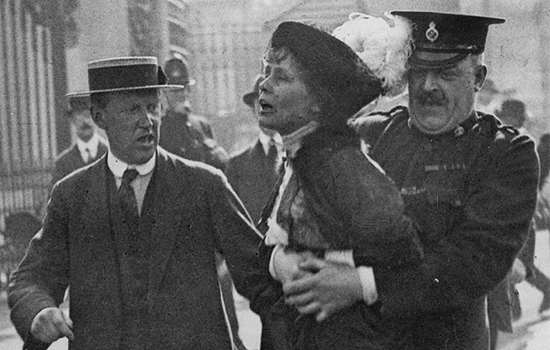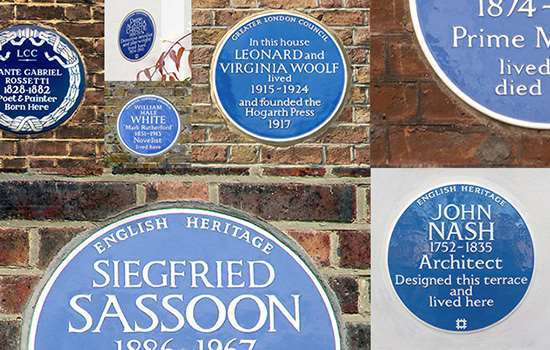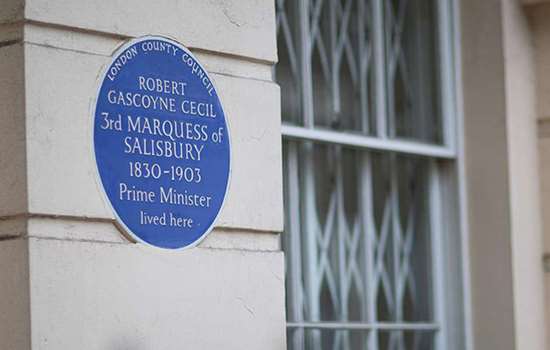MAUNDER, WALTER (1851–1928) & MAUNDER, ANNIE (1868–1947)
Plaque erected in 2022 by English Heritage at 69 Tyrwhitt Road, Brockley, SE4 1QE, London Borough of Lewisham
All images © English Heritage
Profession
Astronomers
Category
Science
Inscription
WALTER MAUNDER 1851–1928 ANNIE MAUNDER 1868–1947 Astronomers lived here 1907–1911
Material
Ceramic
The astronomers Walter and Annie Maunder are best known for their achievements in three main areas: solar astronomy (in particular their work on eclipses and sunspots), their encouragement of amateur astronomy, and their support for women’s participation in astronomy. A blue plaque marks the house in Brockley, south-east London, where the couple lived from 1907 to 1911.
Early careers
Edward Walter Maunder was born in London in 1851, the son of a Wesleyan minister. In 1873 he joined the Royal Observatory, Greenwich, as Junior Assistant for Photographic and Spectroscopic Observation in a new department set up to study sunspots and their effect on the weather. He would remain at the Royal Observatory all his working life, becoming Superintendent of the Solar Department in 1896.
In 1890 Maunder took a leading role in founding the British Astronomical Association (BAA). The new organisation was intended to encourage those who found the Royal Astronomical Society (RAS) subscription too high, to allow women (more or less excluded from becoming RAS fellows) to join, and to encourage the involvement of amateur astronomers. It attracted 500 members by the end of its first year.
Annie Scott Dill Russell, born in 1868 in Strabane, County Tyrone, joined Maunder’s department at Greenwich in 1891as one of the ‘lady computers’. This was part of a scheme to employ educated young women to undertake routine observational duties. The work had previously been done by teenage boys and the posts were poorly paid with no possibility of promotion. The four women appointed had all studied mathematics at Cambridge and worked under non-graduate male assistants.
Annie became Walter’s second wife in 1895. In 1892 Walter, who was always convinced that women had an important place in astronomy, nominated Annie for fellowship of the RAS, but she was turned down because at that point the society did not accept women as full fellows.
A scientific couple
On her marriage, Annie was obliged to resign her post at the Observatory. She probably took on maternal duties in relation to Walter’s five children from his first marriage. Although her education was higher and more specialised than her husband’s, Annie Maunder’s gender prevented her from taking a professional role in the field and she was never again in paid employment as an astronomer.
Nonetheless she continued her active participation in the field for the rest of her life, working with and without her husband. As Walter’s wife, she was able to work on institutional projects and to use specialist equipment. They became a ‘scientific couple’ and it is sometimes hard to separate their achievements. Of their many published papers, books, articles and activities, by far the majority are credited to ‘EW Maunder’, but recent research has revealed that Annie generally contributed to Walter’s publications.
At Tyrwhitt Road
The Maunders’ blue plaque marks 69 Tyrwhitt Road in Lewisham, where the couple lived between 1907 and 1911. They had previously lived at number 86. It was while they were living on Tyrwhitt Road in 1904 that they published an article on sunspots which included a famous ‘butterfly diagram’, produced by the pair working together, which elegantly expressed the regular movement of sunspots during the cycle. From 1903 onwards the pair also successfully challenged the myth that there were built canals on Mars, by showing that what appeared to be straight lines on the surface of the planet were in fact a series of spots or craters.
They were at number 69 when they wrote The Heavens and Their Story (1908), which frequently referred to the nearby park and favourite stargazing spot, Hilly Fields. This was one of several books they published on popular astronomy intended to encourage amateurs, laying the ground for future discoveries by non-professional astronomers.
LEGACY
Both Maunders are commemorated by three craters on the moon, named after them in 1970 by the International Astronomical Union; a crater on Mars (1973) and a minor planet discovered in 1998 are named after Walter. The BAA continues today as one of the world’s leading amateur groups, making scientifically valuable observations, often in collaboration with professional colleagues. In 2016 the RAS (which eventually admitted Annie Maunder as a fellow) launched the Annie Maunder Medal, to be awarded for an outstanding contribution to outreach and public engagement for astronomy or geophysics.
Nearby Blue Plaques
More About Blue Plaques



